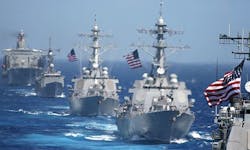Navy reaches out to industry for new technologies to enhance shipboard sensor networking
Officials of the Office of Naval Research (ONR) issued a broad agency announcement on Friday (N00014-16-R-BA07) for the Communications and Interoperability for Integrated Fires (CIIF) future naval capability (FNC) project.
This program will consist of two separate efforts: Communications-as-a-Service (CaaS); and Mission-based Networking for Data Distribution Systems (MiND). Caas seeks to enable data and information to be delivered via any combination of available data links, while MiND seeks to increase the throughput and scalability of the Navy's existing Cooperative Engagement Capability (CEC) data-distribution systems.
The CEC is designed to distribute sensor and weapons data from existing systems by fusing tracking data from participating sensors and distributing it to all other participants using identical algorithms to create one common air defense tactical display, or "air picture," which is based on all sensor data available.
The CEC provides early detection and consistent tracking of air threats such as cruise missiles, manned aircraft, and unmanned aerial vehicles (UAVs). It is based on a high-bandwidth military communications system with electronic countermeasures that blends in the global positioning system (GPS).
Related: The evolution of networked sensors
The CaaS project is to create an on-demand network for the integrated firing of naval weapons via a combination of tactical data links. The idea is not to translate data into different formats but instead to encapsulate the data appropriately through CaaS devices on various platforms to deliver it to the next hop.
The challenge will be to deliver critical data quickly and securely enough to coordinate missiles, bombs, naval guns, and electronic warfare jamming in real time.
story continues below
Key technologies for Caas will include interfaces to various data link systems; ways to sense latencies, loss rates, throughput, and congestion of various data links; establishing data paths based on bounded latency, tolerance to loss of data, and related conditions; deterministic networking to assure the delivery of the highest priority data reliably; and interfaces to request a specific level of service for the data.
Contractors and the Navy experts will use a modeling and emulation environment to assess performance, select the appropriate technologies, and develop an operational prototype to evaluate CaaS in an operationally relevant environment.
The MiND project, meanwhile, seeks to employ the CEC DDS flexibly in support of non-CEC missions. The challenge will be to prevent any adverse impact on the core CEC mission while the DDS is performing these other functions.
Related: Multi-sensor fusion hits the mainstream
Key technologies include new waveforms and coding to improve throughput, reduce latency, and reduce losses; improved distributed resource allocation and scheduling algorithms for directional communications; backward compatibility to ensure that legacy DDS systems work together with the MiND enhancements; and interface with the CaaS device.
ONR designates the Office of Naval Research Laboratory (NRL) in Washington as technical lead and government and industry systems integrator.
Companies interested should submit separate proposals for CaaS and MiND -- even if an offeror intends to submit a proposal for both products.
Navy experts will conduct separate classified industry briefings on 8 and 9 March 2016 for MiND and CaaS, respectively, at the Naval Research Laboratory in Washington. Email requests for spots at the industry day briefings no later than 23 Feb. 2016 to the Navy's Ray Cole at [email protected], with a copy to Jill Brady at [email protected]. Put CIIF Industry Day Registration in the subject line.
Email proposals no later than 29 March 2016 to the Navy's Santanu Das at [email protected]. For technical questions or concerns contact Santanu Das by email at [email protected], or by phone at 703-588-1036.
Related: Raytheon to upgrade Army electro-optical sensors with networking and anti-sniper capability
For business questions or concerns contact the Navy's Keegan Purdie by email at [email protected], or by phone at 703-588-2960.
More information is online at https://www.fbo.gov/spg/DON/ONR/ONR/N00014-16-R-BA07/listing.html.
